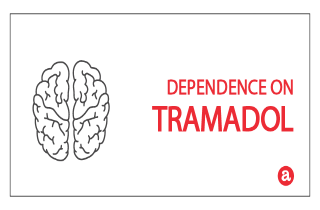Are you concerned about developing a dependence on tramadol?
Developing physical dependence on tramadol is a normal part of how tramadol works. But are you worried you might be addicted to tramadol and wonder, “Can I just stop taking tramadol?” In this article, we’ll explore tramadol dependence vs. addiction to tramadol, and the different strategies used to treat both. Your questions about tramadol are welcomed at the end.
What is dependence on tramadol?
Tramadol dependence is a serious problem that occurs after taking tramadol regularly over time. While immediate release tramadol duration of action is only around 6-8 hours, you can start to need to take tramadol to feel “normal” after weeks of use. In other words, while tramadol is less habit-forming than many other opioids, taking tramadol long term or in high doses will cause you to develop a tolerance – the need to take higher doses for the same effects – and dependence. When you’re dependent on a medication you won’t be able to stop taking it abruptly without withdrawal symptoms. So how and why does dependence occur?
Long-term use of tramadol causes changes in brain chemical systems and circuits. In other words, the brain adapts to constant influx of tramadol by self-adjusting and “slowing down” some processes and “speeding up” some others. When you stop taking tramadol, or significantly lower tramadol dosage, the brain, which has become dependent on tramadol and has adapted to its presence, goes into “over drive”. This is why you go through withdrawal.
Tramadol dependence time: How long to be dependent on tramadol?
If you’re given tramadol for short-term pain relief, such as treatment for a minor injury, illness, or medical procedure, you won’t be taking tramadol long enough to develop a dependence. Typically, it takes about 3-4 weeks of continuous use for someone to become tramadol dependent. The longer you take tramadol and the higher the dose, the more likely you are to develop a dependence.
Dependence on tramadol symptoms
Although dependence on tramadol symptoms symptoms may seem frightening, they don’t necessarily indicate an addiction to the pain medication. Your body is simply used to having tramadol in your system. The main symptoms of a tramadol dependence are:
- needing larger doses for effective pain relief (tolerance)
- experiencing withdrawals when stopping the medication
- the physical need to take tramadol every day
Treating physical dependence on tramadol
How can you treat tramadol dependence? A physical dependence on tramadol can be unpleasant if you no longer need to take tramadol or don’t have a prescription for tramadol and can’t access more of the medication. However, the withdrawal symptoms from tramadol are usually milder than on other opioid medications. Doctors will treat a physical tramadol dependence by gradually lowering your dose over a period of days or weeks, so that your body can slowly adjust to not having the medication in your system. And we recommend that you always seek medical advice when considering treating physical dependence on tramadol.
Tramadol dependence withdrawal
Tramadol withdrawal is pretty unpleasant and can cause:
- mood changes
- insomnia
- panic attacks
- abdominal pain
The only way to treat tramadol withdrawal is ask for medical supervision from your prescribing doctor or a detox clinic. If you no longer want to continue taking tramadol, most experts recommend gradually decreasing your dosage until you can safely go off the medication. If this is not an option, you will eventually stop having withdrawal symptoms, but it can take days or weeks.
Tramadol dependence vs addiction
Tramadol dependence is clinically different from a tramadol addiction. An addiction to tramadol may present the same physical symptoms as dependence, but also comes along with psychological symptoms. These include drug cravings and compulsive tramadol seeking and use despite negative life consequences. You’re more likely to become addicted to tramadol is you’re taking it in a manner other than it would normally be prescribed – such as taking very large doses, or snorting tramadol rather than taking it orally.
Treating psychological dependence on tramadol
A psychological dependence on tramadol occurs when tramadol dependence crosses the line into addiction. If you’re psychologically dependent on tramadol, you will:
- be unable to cope with stress or day-to-day life without taking tramadol
- feel a compulsive need to use tramadol
- feel strong cravings for tramadol
- continue taking tramadol even if it has negative consequences
A psychological dependence on tramadol is much more difficult to treat than a physical dependence. You may need to see a therapist specializing in addiction, join a support group, or ask your doctor about medical interventions to help you break the cycle of tramadol addiction.
Tramadol dependence questions
Do you still have questions about tramadol? Are you unclear about the difference between dependence on tramadol and addiction to tramadol? We welcome all questions in the comments below and try to respond with a personal and prompt reply.









Related Posts